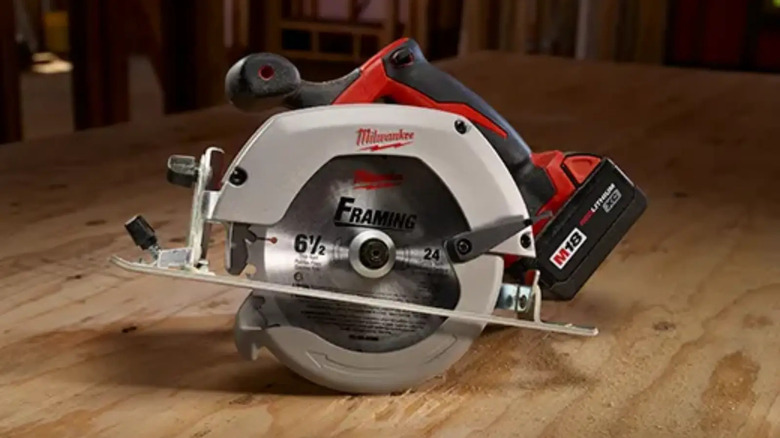Makita Vs. Milwaukee: Who Sells The Better Cordless Circular Saw?
Whether you're a professional woodworker or need a circular saw for an upcoming project, it's important to know the tools that you're buying and whether or not you're getting the best deal in terms of features and price. Going into the tool section of Home Depot, you're bound to notice the rows of Milwaukee red and Makita teal tools belonging to the two competitive tool companies. However, when comparing the brands' circular saws, it's hard to notice much of a difference up front. Outside of a few aesthetic differences, they're nearly identical.
The Makita 18V LXT Cordless 6-1/2 in. Circular Saw, costs $149, and the Milwaukee M18 18V Cordless 6-1/2 in. Circular Saw is priced at $129. Both of these saw are brushed circular saws that have differences in specs and features along with users reviews. You will find a more in-depth breakdown of our methodology at the end of this article.
Examining the specifications and features
When examining a tool as hardy as a circular saw, there are many specifications that come with it. Placing them side by side, the 6-1/2 in blade diameter is the same — however, be aware that both of these saws also come in 7-1/4 in. if you need a bigger blade. They both also work off the same battery voltage of 18V. Additionally, if you're looking for a circular saw with bevel capabilities, both of these saws have a 50-degree bevel capacity.
However, that's where the similarities stop. For the Makita circular saw, the maximum cut depth at 45 degrees is 1.563 in and the maximum cut depth at 90 degrees is 2.25 in. For the Milwaukee circular saw, the maximum cut depth at 45 degrees is 1.625 in and the maximum cut depth at 90 degrees is 2.125 in. These cut dimensions aren't terribly different, but sometimes even a 16th of an inch in cut depth can make a difference for the ease of your project.
Additionally, the maximum speed and weight are different for both saws — Makita's is 3700 RPM and only weighs 7.3 pounds while Milwaukee's is 3500 RPM and weighs more at nine pounds. Both brands also offer a warranty on their tools. Milwaukee comes with a five-year limited warranty — though, Makita's is less with only a three-year limited warranty.
Which is the better cordless circular saw?
It takes more than just specs to determine which tool is better, though. When looking at Home Depot reviews, the Makita circular saw received a 4.7 out of five-star rating from 805 reviewers. Milwaukee has a 4.6 out of five-star rating from over 4,200 people. Milwaukee also shows reviews on its website, which has a 4.4 rating from 239 people.
For the written reviews, many state that the Makita saw is incredibly lightweight which doesn't affect the power that it has. One of the most stated negative reviews is that the saw uses a lot of battery for a few cuts, which means if you're using a small 1.5 Ah battery, you won't get much use out of it. For Milwaukee, many people have written one-star reviews regarding the lack of power behind the circular saw. One person stated that while trying to cut through a piece of plywood, it bound up and stopped working. Another complained that the bolt sheared off during a blade change, while another reviewer stated that there was too much clearance between the blade depth pivot pin and the cast saw body, which caused a wobble. With that being said, there are many other positive reviews saying that it's one of the best saws they've ever used.
In terms of which circular saw is best based on specs and reviews, it seems that Makita's 6-1/2 Circular Saw comes on top. However, that doesn't mean that Milwaukee's circular saw isn't a decent tool as well.
Our methodology for comparing these two tools
To retrieve the information regarding the Makita and Milwaukee circular saws, we thoroughly researched the tools' information pages on the brands' websites and reviewed the Home Depot product pages. By doing this, we ensured that all the information aligned, so we could compare and contrast both the tools' specs and features. In terms of defining which tool was better beyond the specs and features, we looked at ratings and reviews from users — both good and bad. This gave us an idea of which tool is better to use for what kind of woodworking product and how well the tool would last.
As always, we recommend you do more research on both the brands and the tools, especially if you have not already invested in one of the brand's battery lines. You may find that one brand can offer you power tools that will work better for your needs and future projects. For example, Makita has an Outdoor Adventure line that works with the 18V battery system and is great for camping enthusiasts. In the end, it's up to you which power tool brand you think will be the better addition to your tool collection.



